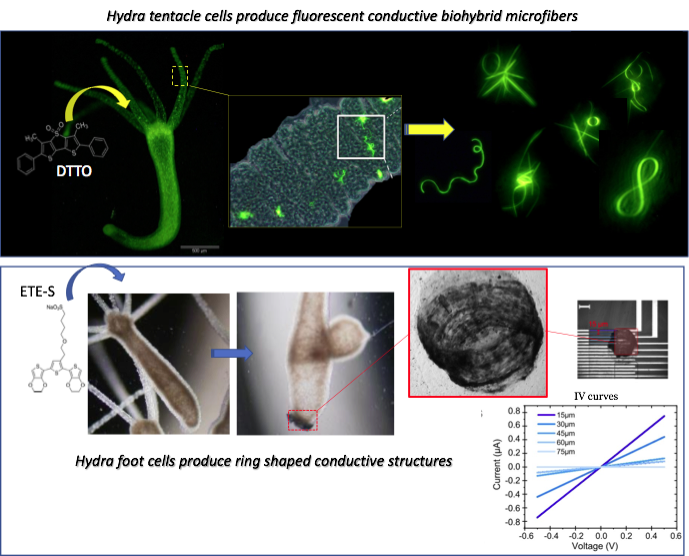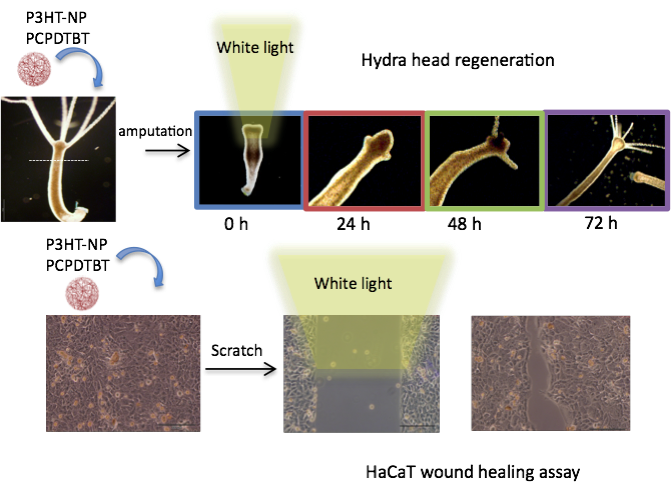NanoBiomolecular Group
Istituto di Scienze Applicate e Sistemi Intelligenti “E.Caianiello”
CONSIGLIO NAZIONALE DELLE RICERCHE


NanoBiomolecular Group
Istituto di Scienze Applicate e Sistemi Intelligenti “E.Caianiello”
CONSIGLIO NAZIONALE DELLE RICERCHE



BIOELECTRONICS
Bioelectronics aim to monitor, actuate or modulate biological processes. Currently there is a major focus on developing implantable bioelectronic devices expressing a minimal mismatch with the hosting biological environment in order to reduce the foreign body response.
Recent non-conventional approaches aim to integrate directly the electronic material into the tissue. In this way exogenously applied compounds that enter biological reaction networks can result in hybrid systems that combine unique features of living organisms with functionality and performance of artificial materials. We address this goal by challenging the tissue-like Hydra vulgaris with organic semiconductor compounds and testing the possibility of augmenting electronic functionality in vivo. In a pioneer work we showed that the semiconducting oligothiophene, DTTO, can promote in living polyps the biogenesis of biohybrid microfibers, produced by co-assembling DTTO with endogenous proteins, and resulting in highly fluorescent and conductive microfibers [1]. In our recent study [2] a conjugate trimer (ETE-S) was shown able to polymerize in specific cell types. The p(ETE-S) functionalized animal tissue acquired electronic conductivity and electrochemical capacitance demonstrating the possibility of augmenting electronic functionality in animals and the biofabrication of electronic biohybrids.
ENGINEERED LIVING MATERIALS

[1] Moros, M., Di Maria, F., Dardano, P., Tommasini, G., Castillo-Michel, H.,Kovtun, A., Zangoli, M., Blasio, M., De Stefano, L., Tino, A., Barbarella, G., Tortiglione, C. In vivo bioengineering of fluorescent conductive protein-dye microfibers iScience 2020 23 (4) 101022
[2] 1.G.Tommasini, G.Dufil, F. Fardella, X.Strakosas, E. Fergola, T.Abrahamsson, D.Bliman, R.Olsson, M.Berggren, A. Tino, E. Stavrinidou, C.Tortiglione. Seamless integration of bioelectronic interface in an animal model via in vivo polymerization of conjugated oligomers», Bioactive Materials, 2022 10: 107-116 . Available on line 28 Aug 2021 https://doi.org/10.1016/j.bioactmat.2021.08.025
Collaborations
Maria Moros, Instituto de Nanociencia y Materiales de Aragón(INMA), Zaragoza, Spain
Eleni Stavrinidou, Laboratory of Organic Electronics, Linköping University, Norrköping, Sweden
Francesca di Maria, Mattia Zangoli, Istituto per la Sintesi Organica e la Fotoreattività (ISOF-CNR) Bologna
Principia Dardano, Luca De Stefano, Istituto di Scienze Applicate e Sistemi Intelligenti

This pioneer work opened the path to current studies with diverse organic semiconductors, to dissect the mechanisms underlying the transduction of light into a biological response. By using biochemical and biomolecular tools we are studying the modulation of the redox balance [2], gene expression levels, and cell proliferation rates as effects of the photostimulation both in Hydra and in human keratinocytes and exploit the possibility to use this control of cell function to enhance tissue regeneration

Related publication:
[1] Tortiglione, M. R. Antognazza, A. Tino, C. Bossio, V. Marchesano, A. Bauduin, M. Zangoli, S. V. Morata, G. Lanzani, Semiconducting polymers are light nanotransducers in eyeless animals. Science Advances. 2017, Vol 3, no.1, e1601699.
[2] Moros, M, Lewinska, A., Antognazza, MR, Di Maria F, Blasio M., lanzani G, TinoA, Wnuk M, Tortiglione C Light-triggered modulation of cell antioxidant defense by polymer semiconducting nanoparticles in a model organism MRS Communication, 2018, 8 (3) 918-925
Collaborations
Maria Rosa Antognazza, Guglielmo Lanzani, Center for Nano Science and Technology, Istituto Italiano di Tecnologia
Maciej Wnuk, Anna Lewinska, Institute of Biology and Biotechnology, University of Rzeszow, Poland
Francesca Di Maria, Mattia Zangoli, Istituto per la Sintesi Organica e Fotoreattività, ISOF-CNR, Bologna
The possibility to control biological function using light provides groundbreaking opportunity in biology and medicine. Intracellular light actuators have several advantages compared to other approaches such as optogenetic, requiring genetic engineering to confer optical responsiveness to the desired cell type. The availability of an injectable device, fully integrated with the tissue, enabling optical control of the cell function may overcome not only cost and time-consuming genetic approaches, but also the issue of spatial and temporal resolution, invasiveness, stiffness and low compliance of the planar light actuators. Nanoparticles (NP) based on organic semiconductors represent valid alternatives, as being biocompatible, biodegradable, support electronic and ionic transport. We demonstrated that poly(3-hexylthiophene) P3HT nanoparticles elicit a behavioral response in the small invertebrate model Hydra vulgaris and induced the modulation of genes involved in the light transduction pathway [1].
Light sensitive devices for optical regulation of living cells